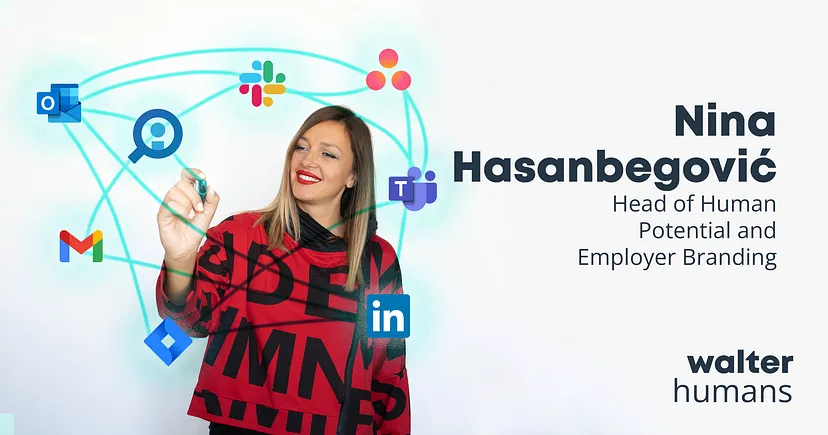
Welcome to an insightful interview with Nina Hasanbegović, a seasoned professional in the realm of Human Potential and Employer Branding.
Nina shared her remarkable journey, from teaching and banking to leading the charge in the dynamic field of HR. As the Head of Human Potential and Employer Branding at Walter Code, she brings a wealth of experience in cultivating positive company cultures, resolving complex employee relations issues, and driving talent acquisition strategies that attract top-tier candidates.
Usually, individuals like Nina are excellent sources of information, inspiration, and motivation for others, so join us as we delve into her career journey and learn more about her unique approach to achieving success.
Meet Nina Hasanbegović!
My professional background is initially not related to Human Potential. I have a master’s degree in German language and literature from the Faculty of Philosophy in Sarajevo, and I started my career as a German language teacher in a high school.
After a year of work, I realized that I needed a more dynamic environment, as well as an environment in which I could develop, so I continued my professional path in the banking sector. Through my career in two banks and an insurance company, I went through various positions and departments, and in the end, I ended up in the HR department as a Specialist in recruitment and training/people development.
I also completed the Employer Branding certification at the Employer Branding College in Australia because I realized that Human Potential and Employer Branding are two inseparable entities in today’s labor market.
After gaining enough experience in HR and realizing that I needed a new, more modern environment, I moved to Walter Code to the position of Head of Human Potential and Employer Branding.
Organization and prioritization of tasks is a very important skill in HP, especially when you are in contact with legal regulations and deadlines related to labor relations. Daily meetings with the team greatly help to deliver all projects and tasks on time, while keeping an eye on priorities. In our business, we use various agile methods to organize time as best as possible, while taking care of deadlines and delivery.
Communication with people is crucial in this department. We often have challenges in teams with different profiles of people.
In one instance, the project manager could not agree with his team of developers, so we had problems with the project. On the one hand, we had a manager who was very organized and wanted all tasks to be completed exactly and precisely within the given deadlines, and on the other hand, we had developers who were not used to pressure and this type of communication, and then they deliberately did not want to carry out their tasks.
To fix it, we held face-to-face meetings, fostering better team collaboration. This personal interaction led to improved understanding and reduced miscommunication, making a significant positive impact.
Transparent and open communication is something that describes Walter Code. It is the basis for maintaining a positive working atmosphere among all employees. We maintain open communication through regular gatherings, townhall meetings, and monthly, and weekly meetings. This approach allows employees to stay informed and actively contribute to our company culture.
Additionally, we organize team-building events, both internally and externally, as well as run the Walter Code Club. These initiatives provide various benefits to our employees, ensuring they feel valued and content in our company. Also, during recruitment, we pay close attention to the profile of the people we employ. It is very important to us that, in addition to the technical knowledge required for a certain position, the person has a profile that fits into our culture, to maintain the positive working atmosphere we have.
In a previous experience, we faced a situation with one team member who was struggling to make a meaningful contribution to a project, leading to consistently poor performance. Through multiple discussions, it became apparent that this team member was grappling with personal issues that were impeding their ability to perform at their best.
We engaged in numerous difficult conversations to reach a resolution that would benefit both parties. Recognizing the employee’s valuable skills, we decided to support their transition into a different role that better suited their abilities and interests. Although this transition posed its own set of challenges, the employee is now a valuable contributor to a different project within the organization, thriving and making a significant impact.
Employer Branding stands as a pivotal pillar in modern recruitment excellence. Our central focus revolves around nurturing employee satisfaction and harnessing their positive influence in the market, a force far more compelling than any conventional marketing effort. There’s no greater affirmation than when candidates enthusiastically share that they’ve encountered glowing praise about our company from those currently immersed in our work culture.
It’s at that moment we realize we’re charting a course of success, one that effortlessly draws high-caliber candidates to our doorstep. This is why we’re actively committed to perpetually elevating employee contentment, empowering them to organically become our most compelling brand advocates.
The process typically starts with a needs assessment. This involves identifying gaps in skills, knowledge, and competencies among employees. This can be done through surveys, performance evaluations, and feedback from managers and employees. Based on the needs assessment, specific learning objectives are established.
These objectives outline what employees should be able to do or know after completing the training. Gathering feedback during and after the training is crucial for assessing its effectiveness. Comparing performance or knowledge levels before and after the training can provide a clear indication of its impact. Managers or supervisors can observe employees in their actual work environment to see if they are applying what they learned.

One of the examples of how we use data analytics is tracking employee turnover, including reasons for leaving, length of employment, department, and performance evaluations. We use this data to identify trends and patterns. There might be a particular department that has a significantly higher turnover rate compared to others. With this data, we make recommendations to address the identified issues. This could include implementing mentorship programs, providing leadership training for managers, and improving communication channels.
The next step is collecting feedback from employees to assess the impact of the changes. This data-driven approach not only helped reduce turnover but also led to an overall improvement in employee satisfaction and performance.
The best way of measuring employee engagement is through clear communication, regular feedback sessions, surveys, etc. Our goal is to gather feedback from employees about their job satisfaction, work environment, management effectiveness, and overall engagement. The HP Team ensures that organizational goals, values, and expectations are communicated clearly to all employees.
Regular updates on company performance and plans can help keep everyone aligned. Through Walter Code Club we also provide opportunities for skill development and career advancement, because employees who feel they are growing and learning tend to be more engaged.

In my free time, I usually do sports activities — hiking, swimming, fitness, and skiing. I have been dancing professionally for a very long time, so training remains a part of my everyday life even today. I also spend a lot of time in nature, so I mostly use my weekends for hiking and swimming in the summer, and skiing in the winter. In addition, in my free time, I do translation, since I am a Court interpreter for the German language, so my free time is mostly filled with different activities.
As we conclude this enriching interview, we’re reminded of the importance of Human Potential and Employer Branding in today’s ever-evolving business landscape. Nina’s journey and insights reflect the dedication, passion, and expertise that shape their role as Head of Human Potential and Employer Branding at Walter Code. With a commitment to open communication, data-driven decision-making, and fostering a thriving company culture, Nina serves as a beacon of inspiration for HR professionals and business leaders alike.
Thank you for joining us in this exploration of HR excellence, and we look forward to more inspiring conversations in the future.